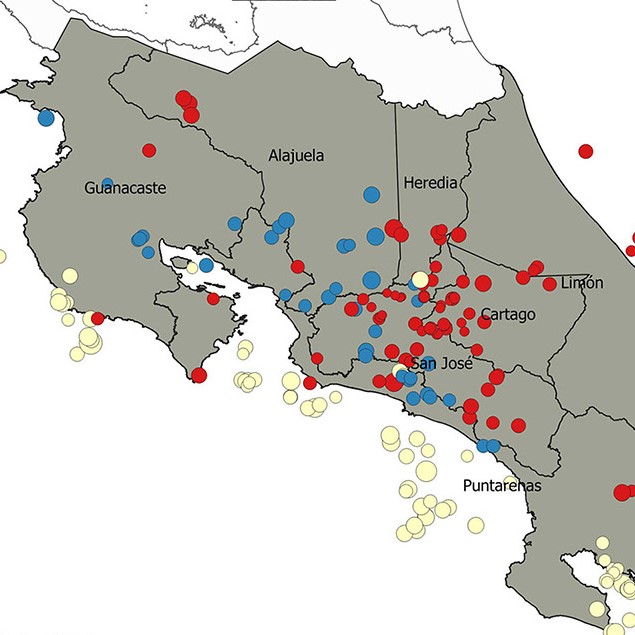Abstract
Seismic waves attenuation models are obtained from accelerographic data and represent one of the most important inputs for seismic hazard studies, which are essential for the design of increasingly efficient seismic-resistant structures and systems. Given that the recording of new earthquakes provides extremely valuable information to update these models and studies, it is necessary that both be reviewed and reconsidered periodically. In this work, a descriptive analysis of accelerographic data recorded in stations in Costa Rica until the year 2021 is presented, as a basis for the subsequent development of attenuation models for the country. The research is motivated by the large number of accelerographic data recorded in the last 11 years, thanks to the densification of the instrument network managed by the Seismic Engineering Laboratory of the University of Costa Rica. This means that, at the present time, there is a sufficiently broad and robust accelerographic database to be able to generate ground motion prediction equations, known as GMPEs, that represent the attenuation in the three tectonic regimes present in the country: crustal, interphase subduction and intraslab subduction. In this stage of the investigation, a total of 3,192 records associated with 245 earthquakes are analyzed, obtained after applying a series of selection filters on a database initially composed of 3,981 records. The analysis has consisted of obtaining the distributions of the number of events and the number of records based on the magnitude, depth, tectonic regime and type of soil at the recording station, classifying it following the criteria of the Seismic Code of Costa Rica (CFIA , 2010). Among the main results of this research, which will condition the ranges of applicability of the models that are developed later, are (1) the identification of a scarcity of records in conditions of hard soil or rock (S1), as well as of high magnitudes at short hypocentral distances and low magnitudes at long distances.; (2) The range of hypocentral distances from the available records is (5-300 km) for crustal earthquakes, (15-300 km) for interphase subduction, and (40-400 km) for intraslab subduction. Finally, two distance measurements were estimated for extended sources, called rupture, R RUP, and Joyner and Boore, R J&B, used when the rupture cannot be considered punctual. These distances have been calculated from the distances for point sources, epicentral and hypocentral, R EPI and R HYPO respectively, following the methodology proposed by Thompson y Worden (2018).
References
Arroyo-Solórzano, M., y Linkimer, L. (2021). Spatial variability of the b-value and seismic potential in Costa Rica. Tectonophysics, 814. doi: 10.1016/j.tecto.2021.228951
Asamblea Legislativa de la República de Costa Rica (2006). Ley Nacional de Emergencias y Prevención del Riesgo No 8488. Recuperado de http://www.pgrweb.go.cr/scij/Busqueda/Normativa/Normas/nrm_texto_completo.aspx?nValor1=1&nValor2=56178
Bommer, J. J., Hernández, D. A., Navarrete, J., y Salazar, W. (1996). Seismic hazard assessment for El Salvador. Geofísica Internacional, 35(3), 227–244.
Colegio Federado de Ingenieros y Arquitectos (CFIA). (2010). Código sísmico de Costa Rica 2010. Recuperado de https://www.codigosismico.or.cr/descargas/CSCR2010.pdf
Climent, Á., Taylor, W., Strauch, W., Villagrán, M., Dahle, A., y Bungum, H. (1994). Spectral strong motion attenuation in Central America. Technical report No. 2-17. Kjeller: NORSAR. Recuperado de https://www.kerwa.ucr.ac.cr/bitstream/handle/10669/86657/1994%20Climent%20et%20al%20SpectralStrongMotionAttenuationinCentralAmericaNORSAR.pdf?sequence=1&isAllowed=y
Dahle, A., Climent, Á., Taylor, W., Bungum, H., Santos, P., Ciudad-Real, M., Lindholm, C., Strauch, W., y Segura, F. (1995). New spectral strong motion attenuation models for Central America. Presentado en Proceedings of the 5th International Conference on Seismic Zonation (Vol. II, pp. 1005–1012). Nantes: Ouest Editions.
Douglas, J., y Aochi, H. (2008). A survey of techniques for predicting earthquake ground motions for engineering purposes. Surveys in Geophysics, 29(3), 187–220. doi: 10.1007/s10712-008-9046-y
Douglas, J., y Edwards, B. (2016). Recent and future developments in earthquake ground motion estimation. Earth-Science Reviews, 160, 203–219. doi: 10.1016/j.earscirev.2016.07.005
Moya-Fernández, A. (2017). Sistema de monitoreo acelerográfico del Laboratorio de Ingeniería Sísmica. Revista Ingeniería, 28(1), 96-114. doi: 10.15517/ri.v28i1.30874
Pinzón, L. A., Hidalgo-Leiva, D. A., Moya-Fernández, A., Schmidt-Díaz, V., y Pujades, L. G. (2021). Seismic site classification of the Costa Rican Strong-Motion Network based on Vs30 measurements and site fundamental period. Earth Sciences Research Journal, 25(4), 383–389. doi: 10.15446/esrj.v25n4.93927
Red Sísmológica Nacional de Costa Rica (rsn). (2021). The Costa Rica National Seismological Network Catalog during 1975-2021. doi: doi.org/10.15517/TC
Schmidt-Díaz, V. (2010). Avances para estudios del riesgo sísmico a escala regional y local: aplicación a América Central y a la Bahía de Cádiz (sur de España) (Tesis de doctorado inédita). Universitat Politècnica de Catalunya, Barcelona, España.
Schmidt-Díaz, V. (2014). Ecuaciones predictivas del movimiento del suelo para América Central , con datos de 1972 a 2010. Revista Geológica de América Central, 50, 7–37. doi: 10.15517/rgac.v0i50.15106
Schmidt-Díaz, V., Dahle, A., y Bungum, H. (1997). Costa Rican spectral strong motion attenuation. Technical report. Kjeller: NORSAR.
Singh, S. K., Gutiérrez, C., Arboleda, J., y Ordaz, M. G. (1993). Peligro sísmico en El Salvador. Reporte técnico 74. México: Universidad Nacional Autónoma de México.
Taylor, W., Santos, P., Dahle, A., y Bungum, H. (1992). Digitalization of strong motion data and estimation of PGA Attenuation. NORSAR Technical Report, 24.
Thompson, E. M., y Worden, C. B. (2018). Estimating rupture distances without a rupture. Bulletin of the Seismological Society of America, 108(1), 371–379. doi: 10.1785/0120170174
Villaverde, R. (2009). Fundamental concepts of earthquake engineering (1a ed., Vol. 1). Boca Raton, Florida: CRC Press.
##plugins.facebook.comentarios##

This work is licensed under a Creative Commons Attribution-NonCommercial-ShareAlike 3.0 Unported License.
Copyright (c) 2022 Víctor Schmidt-Díaz, Luis C. Esquivel-Salas


